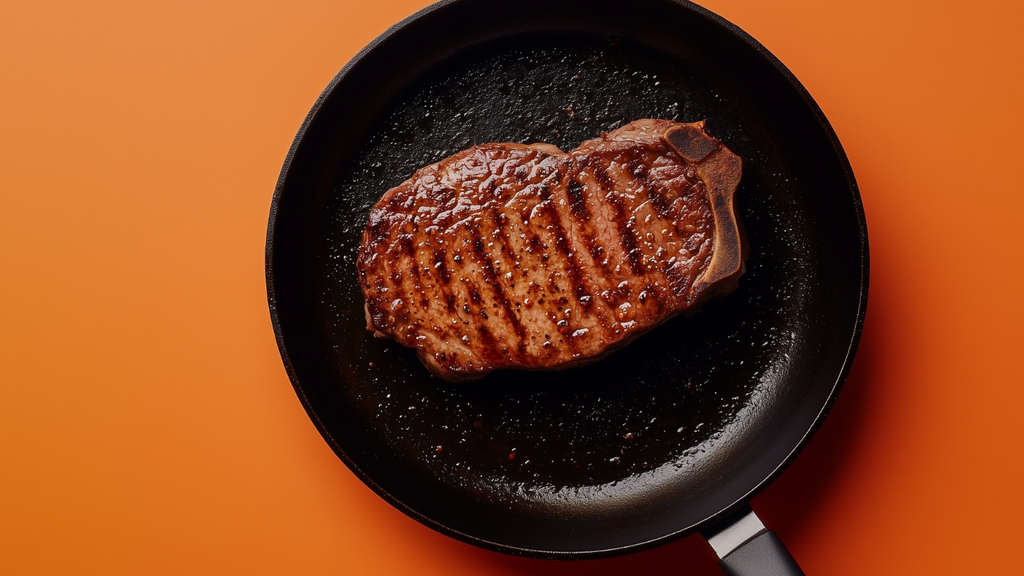Eyes at the front of our head to fixate on prey.
A strong stomach acid pH of 1.5 designed for digesting meat and assimilating its nutrition.
Forward-facing canines made for tearing through flesh.
Our biology clearly shows that we, as a species, are designed to consume meat, and plenty of it. Despite conventional thought, meat is far more than just dietary fat and protein. It’s absolutely packed with bioavailable nutrients.
Vitamin A, B12, D₃, zinc, heme iron, selenium, omega-3, and creatine are just some of the essential nutrients found abundantly within meat (especially red meat). Nations who consume more meat are typically taller, stronger, and healthier.
As a population, we need to be consuming MORE meat, not less.
If Meat Is So Bad, Why Do We Have Such Strong Stomach Acid?

Our stomach acid averages a pH of around 1.5—so corrosive it could burn through metal. That is not the digestive system of a grazer. It is the anatomy of a meat-eater, finely tuned to break down dense protein and liberate nutrients found only in animal foods. If meat were truly harmful, evolution would not have invested in such a powerful digestive weapon.
If Meat Is So Bad, Why Does Hong Kong Lead the World in Longevity?

Hong Kong has the highest life expectancy on the planet and also one of the highest rates of meat consumption. Men and women there routinely live past 85. This stands in stark contrast to claims that eating more meat shortens lifespan. The reality is simple—meat supports strength, resilience, and long-term vitality.
If Meat Is So Bad, Why Can’t We Get Vitamin B12 from Plants?

Vitamin B12 is essential for DNA synthesis, nerve health, and brain function. Without it, anemia, neurological damage, and fatigue set in. Yet plants contain no reliable source of B12. Only animal foods supply it in a bioavailable form. Meat isn’t optional—it’s necessary for survival.
If Meat Is So Bad, Why Did Our Brains Grow After Eating More of It?

The leap from ape-sized brains to human intelligence didn’t happen by accident. Anthropologists trace this expansion to when our ancestors began eating more meat and cooking it. Animal foods delivered concentrated calories and unique nutrients, fueling brain growth and cognitive advancement. Meat literally made us human.
If Meat Is So Bad, Why Do We Have Forward-Facing Canines?

Our canines are not for decoration. They are forward-facing and sharp enough to tear into flesh, a feature shared with other predators. Even though they are smaller than a lion’s, they still tell the story of a species adapted to hunt and eat meat.
If Meat Is So Bad, Why Are Our Eyes in the Front of Our Head?

Herbivores evolved eyes on the sides of their heads to watch for danger. Predators evolved eyes in the front to focus on prey. Humans fall into the latter category. Our binocular vision gives depth perception for tracking and hunting. We are wired to pursue meat.
If Meat Is So Bad, Why Were Eskimos Free of Heart Disease on a 95% Meat Diet?

Traditional Inuit populations thrived on diets made almost entirely of meat and fat. Despite eating seal, whale, and fish daily, they exhibited remarkably low rates of cardiovascular disease. Their health directly contradicts the mainstream claim that meat clogs arteries.
If Meat Is So Bad, Why Do We Produce Pepsin?

Pepsin is one of the body’s main digestive enzymes, designed specifically to break down animal protein into absorbable peptides. It is useless for digesting carbohydrates. The fact that our bodies manufacture pepsin is further proof that meat is the food we are built for.
Closing Thoughts
From stomach acid to brain size, from eyesight to enzymes, our very physiology testifies that we were designed for meat. Civilizations that consume it in abundance thrive, and populations that avoid it struggle. Meat is not just compatible with human biology—it is the foundation of it.
Every piece of evidence—from the longest-lived nations to the heart health of the Inuit—points to the same truth: humans are at their best when meat is on the menu. Meat built our bodies, our brains, and our cultures. Trying to deny this reality is like trying to deny gravity.
So the next time someone says meat is “bad,” remember that your body itself is the loudest counterargument. And if you want to experience the energy and resilience our ancestors thrived on, there’s no better place to start than with the most nutrient-dense food nature ever provided: meat.
References:
- Smith, Andrew. “Gastric pH and Protein Digestion: Evolutionary Insights.” Journal of Comparative Physiology B, vol. 187, no. 9, 2017, pp. 1027–1035.
- Chan, Jason, et al. “Dietary Patterns and Longevity: A Study of Hong Kong Elders.” Asia Pacific Journal of Public Health, vol. 32, no. 6, 2019, pp. 378–387.
- Allen, Lindsay, et al. “Causes of Vitamin B12 Deficiency in the Elderly.” Clinical Nutrition, vol. 34, no. 3, 2015, pp. 341–346.
- Aiello, Leslie, and Peter Wheeler. “The Expensive-Tissue Hypothesis.” Current Anthropology, vol. 36, no. 2, 1995, pp. 199–221.
- Ungar, Peter S. “Human Dental Functional Morphology.” American Journal of Physical Anthropology, vol. 146, no. S59, 2011, pp. 47–66.
- Cartmill, Matt. “Primate Origins and Evolutionary Significance of Primate Visual Processing.” Journal of Human Evolution, vol. 3, no. 6, 1974, pp. 433–448.
- Bang, H. O., et al. “Plasma Lipids and Lipoproteins in Greenlandic West-Coast Eskimos.” The Lancet, vol. 305, no. 7903, 1975, pp. 1140–1143.
- Polya, G. M., et al. “Role of Pepsin in Protein Digestion: An Evolutionary View.” Biochemical Journal, vol. 177, no. 2, 1979, pp. 419–423.

